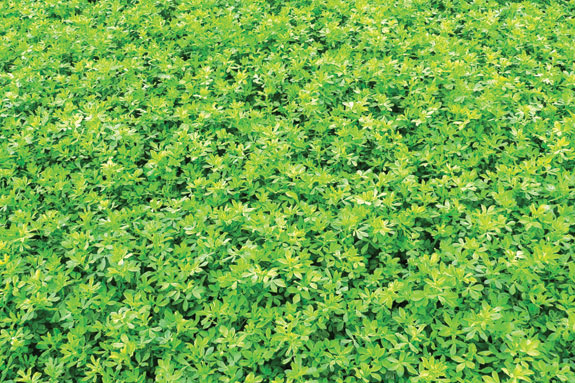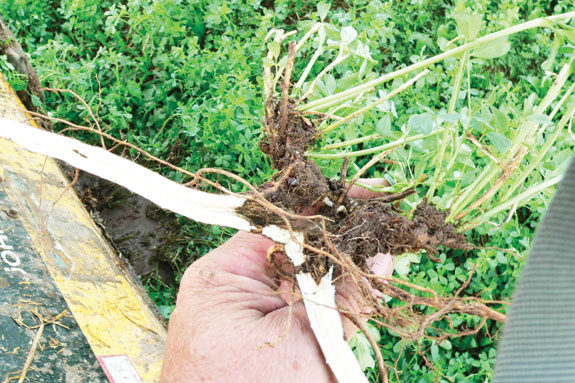“Alfalfa is a perennial plant that stores carbohydrates (sugars and starches) in the crown and root. Plants use these carbohydrate reserves for regrowth both in the spring and after each cutting.

Assuring that the plant has reserves and access to both is the difference in making enough haylage or having to disrupt your bottom line by buying more.”
All indications point to the fact that dairies are going to use more alfalfa hay in the milk-cow rations and reduce the amount of corn because of rising corn costs.
There are some strong indications that we’re going to see a stronger milk price in the months ahead.
So with that in mind, there will be more demand from dairies for high-quality alfalfa hay nationwide.
“It’s critical that we grow as much alfalfa per acre of land than ever before,” Haedt asserts.
Haedt preaches profitable forage production depends on high yields. “Land, machinery and most other operating costs stay the same whether producers are harvesting 3 tons per acre or 8 tons per acre,” he states.
“We are trying to reach the 8 to 10 tons per acre our seed genetics are developed to produce in this region instead of settling for below-average yields of 1 to 3 tons per acre.”
Haedt has been working on getting more clippings per year by having producers understand what is happening in the plant at various times of the year.
His program is filled with basic agronomic sense; however, he has been working with producers to boost the energy of the plant when faced with environmental stresses.
To date his producers are producing 50 percent to 70 percent more alfalfa per year – even last year when drought conditions saw a lot of crops shut down for the year. He says it all starts and ends with available plant energy.
Growth stimulation needed
“A few years ago, we saw a lot of problems associated with herbicides and mold toxins,” Haedt reflects.
“We started to look for more plant-friendly and environmentally friendly production chemicals for our customers.
It was during this time that I was introduced to a new category of chemicals that I like to refer to as ‘plant and yield enhancement’ products.
We’ve known for many years about the products that stimulate the growth of the plant; however, we have never been very successful in determining the catalyst that helps these products produce a positive impact on yield without affecting the plant.
Based on initial trials, I wanted to see how this new plant and yield enhancement product worked in field conditions.”
As is Haedt’s management philosophy, he did not implement the new product until he had tested it thoroughly.
“We set up several small plot replication trials across the state so we could test the new product in varying soil types and growing conditions. What we noticed immediately was a massive expansion of the root system that university testing labs showed improved water and nutrient uptake.
We also noticed a bigger plant that had more leaves from the top of the plant to the bottom. Yields went up significantly, as did forage quality.
In fields where we were barely getting 1 ton per acre prior to application, the plants were now giving us 2.5 tons per acre per cut. There were no holes in the fields. The stands were uniform, and the feed quality was the best we’ve ever produced.”
Providing more energy when needed
“When alfalfa is 6 to 8 inches tall, it begins replacing carbohydrates in the root,” Haedt explains. “This cycle is repeated after each cutting.
High levels of carbohydrate reserves encourage rapid regrowth after cutting and winter survival.
What happens in the plant, though, is that environmental stresses (herbicide damage, weeds, insects, weather) slow the plant’s ability to uptake valuable nutrients because it is reserving its energy to maintain the plant.
Where we see plant and yield enhancement products really excelling is providing the plant with the needed energy to enhance this process without taking the energy out of the plant.
In return, the plant more effectively uses available phosphate, potash and nitrogen and key micronutrients when it needs it most. The result is a stronger plant that withstands a lot more stress and produces more yield,” Haedt states.
“We use the product at the rate of 8 ounces per acre in the early stages of the plant growth as a foliar application.
We will reapply 8 ounces per acre at green-up after harvest in order to propel leaf and stem regrowth of the following crop. I like to apply at 6 ounces per acre on new seedings because the roots are not fully developed,” Haedt outlines.
Fourth-generation dairy farmer Roger Buresh, Luxemburg, Wisconsin, and his two sons, Jeff and Joe, milk 600 cows, farm 1,200 acres and were some of the first producers Haedt worked with on the new plant and yield enhancement product in 2010.
According to Buresh, they had a fourth-year alfalfa stand they were going to put into corn.
When the drought changed his need for more alfalfa, he sprayed the new plant and yield enhancement product on the field to rejuvenate the old field.
“Within 10 days we saw a lot of brand-new growth,” Buresh recalls. “We had bigger leaves that translated in more tonnage and more protein for use in the dairy.
The feed value was as nice as we’ve ever had – even in the drought year. We went from 3 tons per acre to 8 tons per acre, and we had extra haylage in a year when everybody is short.”
Buresh applied plant and yield enhancement product before the first crop was cut in the spring, after the plants were a few inches tall.
They used the full 8-ounce-per-acre rate. He applied a second application with his herbicide and the nutrient mix after the second cutting and all subsequent cuttings.
“We have mixed the product with a wide variety of herbicides, insecticides and fertilizers with no problems, which keeps applications to a minimum and compaction issues at bay.
“We had people stopping on the road to look at how big the leaves were, “ Buresh notes. “In the middle of a very droughty year, these plants were really green, produced extra large leaves and gave us the tonnage we were hoping for.
We could see the water retention value in the plant and that showed up with yield and forage quality.”
It was that increased plant energy and water retention that Richard Britzke, Tigerton, Wisconsin, says increased his yields from 4 tons per acre to 8 tons per acre.
“What we noticed in the treated fields was a much better root system, better water retention that resulted in the bigger yields,” notes Britzke, who farms 750-plus acres with his son, Josh.
“Quality forage is our primary concern. We estimate that 70 percent of the health problems that we deal with in our dairy is due to forage quality. This combination of plant and yield enhancement and micronutrients really paid for itself during the drought.
We were cutting high-quality alfalfa when most were not. The reason we had 8-ton yields was because the plants produced a lot more roots and repelled a lot of the stress factors we were seeing.”
2013 outlook
Haedt says he already has growers asking, “What can we do if we see a lot of overwintering damage in alfalfa fields this season?”
“After three years of data, what I am going to recommend is that we first examine the root systems and see if they are viable. If so, I am recommending an application of plant and yield enhancement and a good micronutrient package to make sure the roots start the season fully charged and healthy,” states the crop specialist.
“Then I would follow with the same program after the first and second cutting. If we can get the mix out after the first and second cutting, I may hold back an application for the third cutting and repeat the program after the fourth and fifth cuttings.
“With the success we’ve had over the past two to three years, combined with the ease of tank-mixing other chemicals with the mixture and low cost per acre, most of my customers don’t skip a treatment.
Last year where we utilized this program we were able to get our plants to come through the stress and perform exceptionally well.
With some of our fields yielding 8 tons per acre, we feel we are getting our farmers closer to the 10-ton average we know their seed was designed to produce,” Haedt states. FG
Steve McKinley, MS, Ph.D., has been writing about agronomic advances for more than 30 years.
PHOTOS
FIRST:Extended root growth on treated alfalfa acres
SECOND: Longer roots needed to reach nutrients and water during drought conditions
THIRD: Uniform alfalfa crop key to maximizing yields
FORTH: Certified crop adviser Mike Haedt (left) and producer Richard Britzke of Tigerton, Wisconsin, discuss alfalfa plant and yield enhancement.
FIFTH: Fourth-generation dairy farmer Roger Buresh of Luxemburg, Wisconsin was one of the first producers to work with Haedt on yield enhancement products. Photos courtesy of Steve McKinley.








